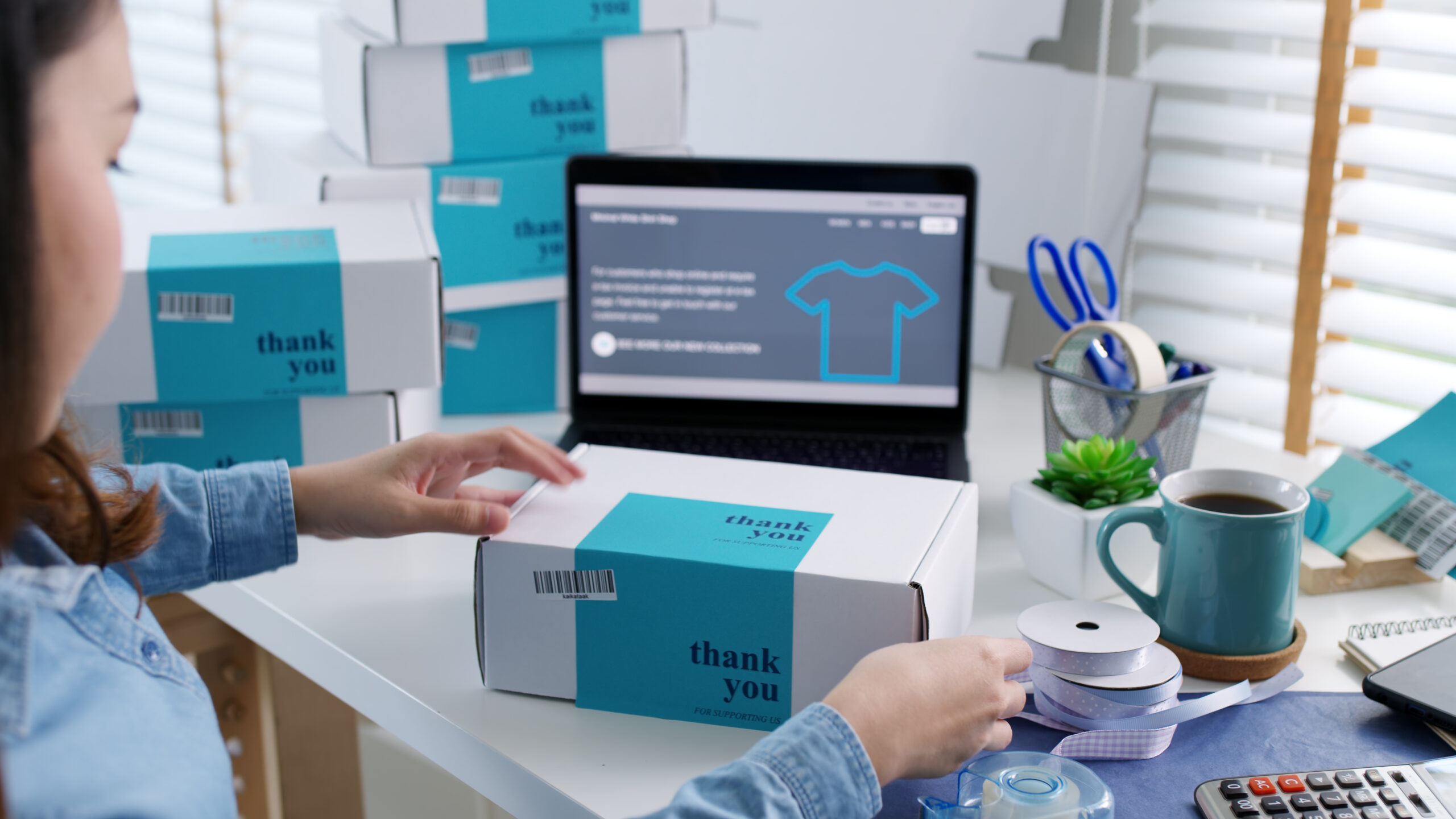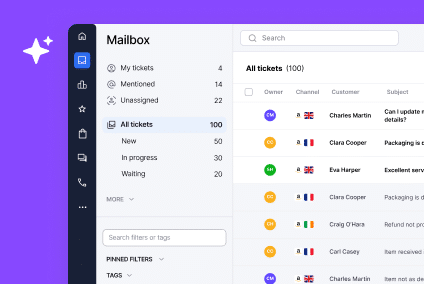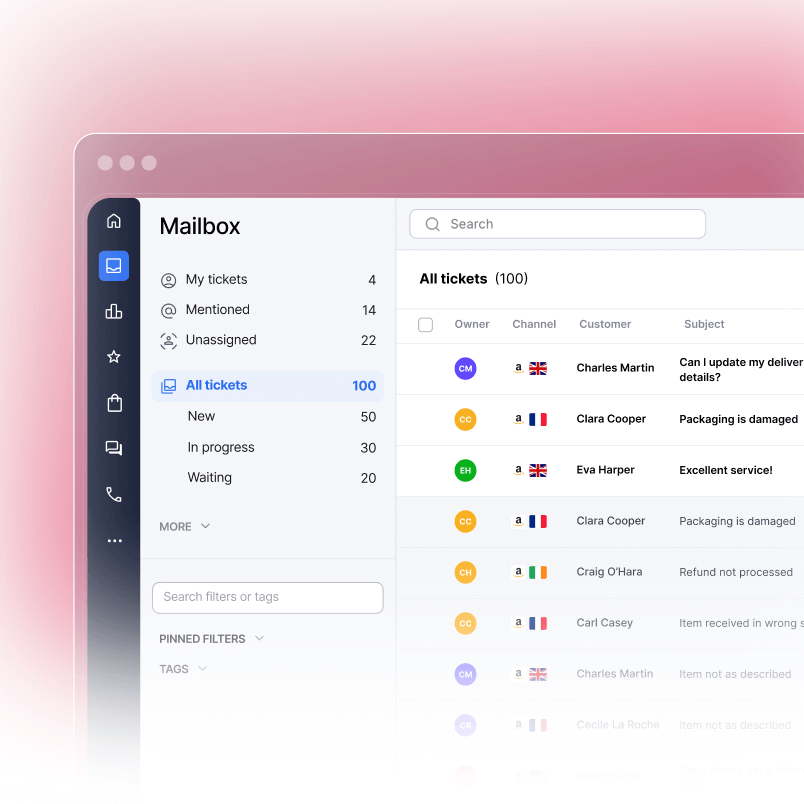When you launch a dropshipping store on Shopify, you gain the freedom to skip warehousing, inventory management, and shipping logistics. What you can’t skip is customer service. Your customers don’t know or care that you don’t hold stock. They expect responses to their questions, tracking updates, and help when things go wrong. The challenge is delivering that level of service when you rely on third-party suppliers and can’t see products move through your own warehouse.
This guide walks you through the entire support process. You’ll learn how to prevent problems before they happen, craft responses that build trust, and set up systems that work even while your suppliers handle fulfillment. Research from industry experts confirms that exceptional customer service in dropshipping directly influences customer loyalty and repeat purchases.
What Makes Dropshipping Customer Service Different
Customer service in dropshipping operates under a completely different set of rules than traditional retail. You’re not managing inventory in a warehouse you control. You’re not packing boxes or handing items to a shipping carrier. Instead, you’re orchestrating a relationship between your customers and a third-party supplier. This structural difference changes everything about how you approach support.
In traditional ecommerce, the retailer owns the entire process from purchase to delivery. They see the product in their hands, they pack it themselves, and they control the timeline. If something goes wrong, they have direct answers. A dropshipper has visibility over only the beginning and end of the process. The middle part, where most delays and mistakes happen, belongs to the supplier.
This means your support role is different. You’re not troubleshooting product issues you can verify yourself. You’re advocating for your customer to a supplier you might not have direct leverage with. You’re translating between your customer’s expectations and your supplier’s capabilities. You’re the buffer between two parties with misaligned timelines and communication styles.
The upside is that dropshipping removes massive operational burdens. The downside is that it adds complexity to customer service. You need strategies and systems that work in this in-between space. Understanding the fundamentals of dropshipping helps you set realistic expectations from day one. Our ultimate guide to dropshipping on Shopify covers everything you need to know to succeed in this model.
Why Your Support Approach Must Change Without Inventory
The Problem: You’re Caught in the Middle
When a customer emails asking where their order is, you face a unique challenge. You didn’t pack it. You didn’t ship it. Your supplier did, but they might be slow to respond. You’re the face of the company, so the customer’s frustration lands on you first. This gap between what customers expect and what you can directly control is the core tension in dropshipping support.
Traditional retailers hold inventory and manage fulfillment. They know exactly what ships and when. Dropshippers depend on supplier timelines, international warehouses, and communication that’s often slow or unclear. If a supplier takes three days to respond to your escalation while your customer waits for answers, that delay is now your reputation problem.
Research shows that 90% of customers expect a response to their customer service inquiries within 24 hours. For dropshippers working across time zones and supplier networks, meeting this expectation requires deliberate systems and automation. This is where tools like eDesk become essential for managing multiple supplier communications simultaneously. Studies on customer support metrics show that fast response times directly correlate with higher customer satisfaction and retention rates.
Your Core Responsibilities
Even though suppliers handle fulfillment, you remain responsible for the customer experience. You need to communicate shipping timelines, handle returns and refunds, answer pre-sale questions, and escalate issues to suppliers when problems arise. Think of yourself as the middleman who smooths the relationship between the customer and the actual fulfillment partner.
Responsibility Matrix for Dropshipping Support
| Responsibility | Your Role | Supplier’s Role |
| Customer Communication | You send all updates and responses | They provide tracking and stock status |
| Pre-Sale Questions | You answer product details, specs, shipping time | They confirm if product is in stock |
| Tracking and Shipping | You relay information to customers | They pack, ship, and provide tracking |
| Returns and Refunds | You process the request and update customer | They receive return and confirm receipt |
| Stock Issues | You notify customers of delays or cancellations | They manage inventory and allocate stock |
Setting Clear Expectations on Your Shopify Store
The best customer service is support you don’t have to provide. When expectations are clear from the start, fewer customers reach out confused or angry. Your Shopify store is the first place to set those expectations.
Add Shipping Timelines to Product Pages
Include expected delivery time directly on product descriptions. Don’t hide this information. If your supplier takes 7 to 14 days to process and ship, plus another 10 days for transit, say so. Customers appreciate honesty more than speed claims that backfire when delivery takes longer.
Many dropshippers list « 7-14 days » processing but forget to add shipping time. Include the full timeline. If it’s 14 to 21 days total, customers who see that upfront are far less likely to panic on day 15.
Create a Dedicated FAQ Section
Build a FAQ page on your Shopify store that answers the five questions your support gets most often. Common questions in dropshipping include delivery timeframes by region, return policies, how to track orders, refund timelines, and whether you accept exchanges. By answering these on your site, you reduce inbound support volume by 20 to 30 percent.
Include a Contact Page With Response Time Promise
Add a contact page that shows customers you’re available and responsive. Promise a specific response time, like « We respond within 24 business hours. » Then actually meet that promise. This sets expectations and reduces follow-up emails from customers thinking you’ve ignored them.
Use Live Chat or a Chatbot for Quick Answers
A chatbot or live chat tool handles the most common questions instantly. Customers asking « How do I track my order? » or « What’s your return policy? » get an immediate answer, not a 24-hour wait. This also reduces the volume of support emails you have to manually answer. Tools like eDesk’s built-in chatbot automation make this setup straightforward even for solo store owners. An AI chatbot for ecommerce can handle routine inquiries while you focus on complex issues that require human judgment.
Common Support Scenarios With Ready-to-Use Scripts
Use these templates to respond faster and stay consistent. Copy them into your support tool and adjust for your brand voice. Having response templates ready prevents long delays and keeps your tone consistent across every customer interaction. Pre-written customer service email templates save time and ensure professionalism in every message.
Scenario 1: Where’s My Order?
Customer Message: « I ordered on Monday and it’s been 6 days. Where is my package? This is taking too long. »
Your Response:
Hi [Customer Name],
Thanks for reaching out. Your order [#12345] is being processed and prepared for shipment by our fulfillment partner. Since orders typically take 7 to 14 days to process and ship, you’re currently within the expected timeline.
Once your package ships, you’ll receive a tracking number via email. You can then monitor delivery progress in real time. I’ll also check for any updates on my end and send you the tracking details as soon as they’re available.
If we haven’t shipped by day 14, I’ll investigate immediately.
Thanks for your patience.
Best, [Your Name]
Scenario 2: Product Doesn’t Match the Listing
Customer Message: « I received my order but the product is different from what I ordered. The color is wrong and the quality looks cheap. »
Your Response:
Hi [Customer Name],
I’m sorry the product didn’t meet your expectations. I’d like to help make this right. Can you send me a photo of what you received compared to the product listing? This helps me understand the issue.
Once I review, I have two options for you:
- Full refund, no return required.
- A replacement shipped immediately at no cost.
Which works better for you? I’ll prioritize this and get you a resolution within 48 hours.
Thanks for giving us a chance to fix this.
Best, [Your Name]
Scenario 3: Slow Shipping Response
Customer Message: « You said 7 days and it’s been 10. I want a refund or an explanation. »
Your Response:
Hi [Customer Name],
You’re right. I promised 7 days and you’re now at day 10. I sincerely apologize for the delay. I’ve just escalated your order to our fulfillment team to find out exactly what’s happening and get you an immediate status update.
I’ll follow up with you within 24 hours with either a tracking number or a full refund. There’s no excuse for this timeline miss, and I’ll make sure this doesn’t happen again.
Thank you for your patience.
Best, [Your Name]
Scenario 4: Return or Refund Request
Customer Message: « I don’t want this item. How do I return it for a refund? »
Your Response:
Hi [Customer Name],
I can process your return. Here’s what to do:
- Reply with your order number and the reason for return.
- Ship the item back to [Return Address] at your own cost (unless it’s defective).
- Once we receive and inspect it, we’ll issue your refund within 5 to 7 business days.
If the item arrived damaged or defective, we cover return shipping. Let me know and I’ll send you a prepaid label.
What’s the reason for the return? That helps me improve.
Best, [Your Name]
Scenario 5: Out of Stock or Cancelled Order
Customer Message: « I just got an email saying my order was cancelled. Why? I already paid. »
Your Response:
Hi [Customer Name],
I apologize for the inconvenience. Your order [#12345] was cancelled due to unexpected stock unavailability at our supplier. This is rare, but it does happen with dropshipping.
Here’s what I’m doing for you:
- Full refund processed today. It will appear in your account within 2 to 5 business days.
- You can reorder a similar item if interested, and I’ll give you a 15 percent discount code as an apology.
I’m sorry we couldn’t fulfill this order. I’m working with my supplier to prevent this from happening again.
Best, [Your Name]
Your Support Workflow From Email to Resolution
Here’s the process your support team, even if it’s just you, should follow when an email arrives.
- Customer sends email about order issue
- You receive email in your helpdesk or Shopify inbox
- You triage the issue by checking order status and contacting supplier if needed
- If it’s a simple question, you answer directly with a script
- If it requires supplier action like stock or tracking, you contact the supplier immediately
- You update the customer while you wait for supplier feedback
- Supplier responds with information or resolution
- You deliver the final answer to the customer
- You document the issue to prevent future occurrences
This workflow ensures customers never wait in silence. Even if you don’t have the answer yet, they know you’re working on it. That transparency builds trust. Documenting patterns helps you improve faster and prevents the same issues from recurring. Using a support ticket system keeps everything organized and trackable, even as your business grows.
Support Tools Built for Shopify Dropshipping
You need tools that integrate with Shopify and connect to your suppliers. Here’s what works.
Helpdesk and Live Chat Tools
eDesk
Best for dropshipping stores that need full visibility. eDesk integrates with Shopify and gives you message templates, automation, and the ability to manage all customer conversations in one place. You can see order details, customer history, and supplier information without leaving the dashboard. eDesk specializes in solving the exact communication challenges dropshippers face. With features like pre-built email templates and automated workflows, you save hours each week on repetitive support tasks. Learn more about the best ecommerce helpdesk software to see how eDesk compares to other solutions.
Tidio
Best for live chat and chatbot support. Tidio lets you set up automated responses for common questions, handle live chat, and send proactive messages to customers. The free plan covers basic needs for new stores. Tidio is one of the best live chat apps for Shopify, offering an affordable entry point for new dropshipping businesses.
Shopify Inbox
Best for store owners who want free, native support. Shopify Inbox is built into your admin panel and handles emails, Facebook Messenger, and Instagram Direct Messages in one dashboard. It’s limited compared to dedicated tools, but it’s free and easy to set up.
Order Tracking and Supplier Integration
Track123
Best for real-time order tracking. Track123 syncs with your Shopify store and auto-sends tracking updates to customers. It reduces support emails about « Where’s my order? » by up to 40 percent.
AfterShip
Best for multi-supplier tracking. If you work with multiple dropshipping suppliers, AfterShip consolidates tracking information and keeps customers updated automatically.
Zendrop
Best for supplier management and tracking. Zendrop is both a supplier and a platform that shows you inventory, processing times, and tracking in real time. If your supplier is also your dropshipping app, this eliminates the disconnect between your store and fulfillment.
Tool Comparison by Function and Integration
| Tool Name | Primary Function | Shopify Integration | Best For |
| eDesk | Helpdesk and automation | Native integration | Full support workflow |
| Tidio | Live chat and chatbot | Direct connect | Fast response times |
| Track123 | Order tracking | App install | Reducing « where is my order? » |
| Zendrop | Supplier and tracking | Native | Suppliers who also track |
Preventing Support Issues Before They Start
Fix problems at the source rather than in email.
Vet Your Suppliers Carefully
Before you add a supplier to your store, test their communication and turnaround times. Order a sample product yourself. Check their Service Level Agreement, or SLA. Look at reviews from other sellers. A supplier that responds in 24 hours will save you dozens of support headaches compared to one that takes a week to reply.
Create a supplier scorecard. Track response time, shipping time, defect rate, and refund handling for each supplier. Rotate out suppliers who consistently miss targets. Understanding the fundamentals of dropshipping, including supplier evaluation, gives you a competitive edge from day one. Learning how to choose dropshipping products strategically helps you select both better products and more reliable suppliers. Resources like Inventory Source’s guide to excellent customer service for dropshippers offer practical frameworks for selecting suppliers who align with your service standards.
Test Products Yourself
Before you market a product to customers, order it yourself and examine it in person. Check the quality, packaging, accuracy of photos, and delivery timeline. If the product doesn’t match the listing or the quality is poor, your customers will tell you through support tickets.
This single step prevents the most common support issue: « Product doesn’t match the listing. »
Automate Tracking Updates
Set up automatic email notifications when orders ship and when they’re out for delivery. Use a tool like Track123 or AfterShip to send these emails without your involvement. Customers who receive automated tracking updates are 50 percent less likely to email asking for a status.
Monitor Support Conversations for Patterns
If you’re getting multiple questions about the same thing, update your product page, FAQ, or store policies to address it. If five customers ask « How long does international shipping take? » add that to your FAQ or homepage. If three customers say the photos are misleading, retake the photos.
Your support conversations reveal gaps in your store information. Use that feedback to prevent future tickets.
Use Product Reviews to Build Trust
Customer reviews provide social proof and reduce support questions. A product with 20 five-star reviews and comments like « exactly as described » makes new customers confident enough that they skip the pre-purchase email. They buy with confidence, and you save the support interaction.
Scaling Support as You Grow
You can’t be available 24/7 as a solo operator. Here’s how to grow support without losing your mind.
Many successful dropshipping businesses implement ecommerce automation strategies to scale their support without hiring immediately. Automation doesn’t replace customer care, it amplifies it by freeing your time for complex issues.
Set and Communicate Response Times
Promise what you can deliver. If you can respond within 24 business hours, say so. If you can only check email twice a day, be honest. Customers respect realistic timelines. Under-promise and over-deliver. If you say 24 hours and respond in 12, customers feel served.
Create a Support Priority List
Not all support emails are equal. A customer with a real problem, like a wrong item or missing package, gets priority over someone asking general questions. A customer who’s been waiting 10 days for tracking gets a faster response than someone on day 2.
Prioritize by urgency and impact on customer experience, not by who emailed first.
Batch Your Support Time
Check and respond to support emails at set times, not constantly. Check at 9 AM, 1 PM, and 5 PM. This prevents constant context switching and keeps you focused. It also prevents you from responding to angry emails in a reactive mood.
Automate Low-Value Responses
Use templates and automation for common questions. Every time you type « Your order typically takes 7 to 14 days, » that’s time you could automate. Move these to chatbots or quick templates so you only write custom responses for complex issues. Learning how to write time-saving response templates is a core skill that separates efficient teams from overwhelmed ones.
Build a Support Knowledge Base
Create a private wiki or document that lists solutions to every support issue you’ve solved. When a similar issue arrives, you skip the problem-solving step and go straight to the solution. This also helps if you eventually hire support help. They can reference your documented solutions.
Outsource to a Virtual Assistant or Support Service
If support volume is growing, hire a virtual assistant in a lower-cost country to handle first-level tickets. They handle basic questions and escalate complex issues to you. For a few hundred dollars per month, you reclaim hours of your time. This frees you to focus on strategy instead of being trapped in support tickets. For additional strategies on managing returns and refunds, Supliful’s guide to providing good customer service in dropshipping covers advanced techniques for balancing customer satisfaction with operational efficiency.
How Support Drives Retention and Revenue
Good support keeps customers around and drives repeat purchases. A customer who had a problem and saw you fix it is often more loyal than a customer who never had a problem. They know you care.
According to research, 73% of consumers say that customer service is an important factor in their brand loyalty decisions. For dropshipping businesses, this connection is even stronger. When you handle a problem well, you prove you’re invested in their experience despite not holding inventory. This is why building systems now, before you scale, pays dividends later. Learning how to retain your customers with better support creates a sustainable competitive advantage as you grow. For deeper guidance on managing the unique challenges of dropshipping customer service, HeroThemes’ comprehensive guide on customer service in dropshipping covers best practices and actionable strategies.
Support also feeds your marketing. A customer with a great experience becomes a word-of-mouth advocate. They recommend you to friends. That’s free growth.
Finally, support data tells you where to improve your product sourcing, descriptions, and marketing. If 20 percent of orders come back with the same complaint, that’s your signal to find a new supplier or rewrite the listing.
Your support system today shapes your scaling tomorrow. Start now with the tools and processes that fit your current size. As you grow, you can layer in automation, hire support staff, and refine workflows. The foundation is the same: clear expectations, quick responses, and real solutions. Industry resources provide additional insights on building dropshipping customer service systems that sustain growth and build brand loyalty.
FAQs
How do I handle customer service when dropshipping on Shopify?
Set clear expectations on your product pages and FAQ about processing time and delivery timelines. Use a helpdesk tool like eDesk or Shopify Inbox to stay organized. Create response templates for common issues. Track orders proactively. Most importantly, respond to every customer email within 24 hours, even if your response is « I’m looking into this and will update you tomorrow. »
Who is responsible for refunds when I dropship, me or the supplier?
You are responsible to the customer. The customer paid you, so they expect you to handle refunds. You then work with the supplier to recover the refund. Your return policy should be clear about who bears shipping costs, typically the customer unless the product is defective. Understanding effective ecommerce returns management strategies helps you handle these situations smoothly.
Can I offer fast shipping and support if I don’t hold inventory?
Yes, but only if your suppliers are fast. Choose suppliers with short processing times and located in regions close to your customers. Use automated tracking to keep customers updated. Set expectations upfront so customers don’t expect next-day delivery. Speed comes from supplier choice and communication, not from you holding stock.
What helpdesk is best for Shopify dropshipping?
eDesk integrates with Shopify and provides automation, templates, and full order visibility. Shopify Inbox is free and built in. Tidio adds live chat and chatbot features. The best choice depends on your support volume and budget. Start with Shopify Inbox or Tidio, then upgrade to eDesk as your store grows. Comparing helpdesk for Shopify options helps you make the right choice for your stage of business.
How do I reduce the number of support emails?
Add clear shipping timelines, return policies, and tracking instructions to your store. Use automated tracking notifications so customers don’t ask for status updates. Create a comprehensive FAQ. Use a chatbot to answer common questions instantly. Vet suppliers to prevent defective products. Most support volume comes from unclear expectations or missing information, not from unsolvable problems.
Can I use canned responses or templates without sounding robotic?
Yes. Use templates as a starting point, not the entire response. Customize each answer with the customer’s name, order number, and a personal touch. Add a specific detail from their email to show you read it. « I see you ordered on Sunday » is better than a generic template. Customers tell the difference between a template and no response at all.
What should I do if a supplier goes offline or disappears?
Have a backup supplier for your top-selling products before you need one. If a supplier disappears, switch immediately and inform your customers. Offer refunds or replacements for any orders affected. Use this as a learning moment to diversify your supplier base. Never rely on a single supplier for critical products.




